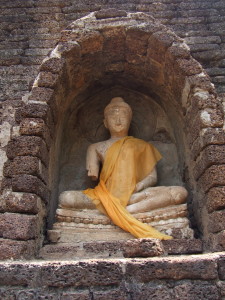 Neither one of us said anything for several minutes. Only the occasional slurping of tea could be heard.
Neither one of us said anything for several minutes. Only the occasional slurping of tea could be heard.
“When I little girl, I so scared,” said Ann, a Laotian I had met earlier that day and invited me in for tea.
“We living in village close to Sepon, near eastern border between Laos and Vietnam. We so poor, my family. Always not enough to eat. And every day, I look outside and bombs falling and falling. Everything burning: houses, animals, my people. One day, our village on fire so my father take us. To another village. For many days, we walking and walking.”
She paused. Then she said, “And on road, we see so many dead bodies. But my father always say to us to keep moving, must keep moving.”
Here was a woman who had seen her entire country razed to the ground and yet she thought I was brave for traveling solo in Laos. She had done the bravest thing of all: to put one foot in front of the other on a corpse-riddled road. Just to survive. To not let the most ghastly sights slow her down.
It was a secret war in Laos from 1964 to 1973 that had raged all throughout the country, occupied by the Americans and Vietnamese at the cost of thousands of innocent lives. Even though Laos was technically a neutral state, the Vietnamese stayed anyway and took over the eastern part of Laos along the infamous Ho Chi Minh trail. And for many years, the Americans dropped bombs to stop the spread of communism in and around the Ho Chi Minh trail. Not many knew about Laos and their unwanted role in it. It was forgotten, hidden in CIA files and memos that only recently came to light.
“Ann, I can’t…imagine how you must’ve felt seeing all those dead bodies.”
“Yes, what to do? Stay beside death and cry? No, you move. Always moving. Must leave war and death behind you.” She sighed, her long breath coming deep from her belly, and she set her teacup down for the last time.
She didn’t say any more about it. I prompted her to continue, but she was silent. Her face looked sadder, and I stopped my queries that seemed to pull down the corners of her mouth. I knew I had gone as far as I could with her about the war.
Instead, she leaned back in her chair and we chatted politely about my trip to Lao Pako the next day, and the upcoming journey north to Luang Prabang. We finished our talk just in time for the power to go out, as it always seemed to at the same time every night. She lit a candle, placed it in a metal holder and then gave it to me, her palms encircling my own.
“Good luck to you. I enjoy our talk,” she said, her eyes searching my face.
“Thank you. I really appreciated it and more than anything I—”
“Ssssh,” she hushed me. “No need to say. My country suffer so much during war. I lucky am alive. Live your life.”
Bowing my head out of respect, I clasped my hands together and she reciprocated. When I lifted my head, she had already crossed the room, the long back panel of her silk dress swirling behind her.
This was an excerpt from THE SAME SKY. If you’re like to read more, you can click here.
2 Comments
Comments are closed.

Thanks for sharing Debbie, it’s a fantastic and insightful section of the book. Connecting with locals provides a completely new level of connection with a country.
Thanks! Yes so true – when you connect with a local who has lived through so much pain and grief, you get such a different perspective of the country that you normally wouldn’t discover. God bless Ann, the woman in my story…